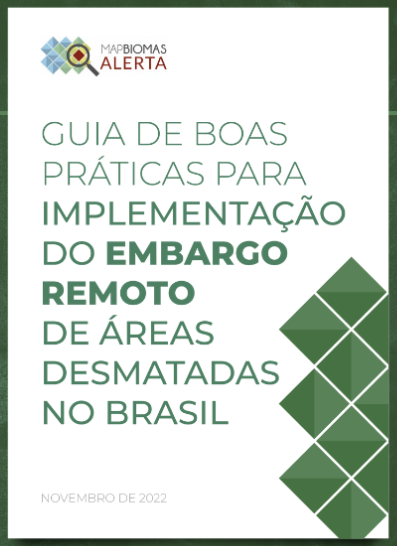Guia de Boas Práticas, lançado esta semana, visa dar escala à prática que faz uso de recursos tecnológicos disponíveis e acessíveis a todos

Access the Good Practice Guide for implementing Remote Embargo of deforested areas in Brazil
Almost all (98%) of the more than 200,000 deforestation alerts, totaling 4.3 million hectares, validated by MapBiomas Alerta between 2019 and 2021, had evidence of illegality. However, only 7% of them, corresponding to 27% of the deforested area, were the object of some action - be it an authorization, embargo or public civil action, for example. One of the factors for this is the lack of structure of the inspection bodies, which still privilege face-to-face actions. But the scenario could be totally different with the use of technology: resources available quickly and for free already allow the identification of the suppression of native vegetation with high resolution images, allowing remote embargoes.
"Remote embargoes are strategic in our current context in which environmental agencies still don't have enough human and financial resources to efficiently attend the high number of confirmed deforestations", explains André Lima, coordinator of the Climate and Sustainability Radar project, from the Democracy and Sustainability Institute (IDS). "Today the available and widely accessible technologies offer two fundamental conditions for remote monitoring: the reliability and timeliness of the information. Its use, therefore, is essential for environmental inspection in Brazil to achieve the necessary celerity to combat the destruction of our biomes," adds Tasso Azevedo, general coordinator of MapBiomas.
For the practice of remote embargo to become widespread, representatives of state and federal environmental agencies and civil society organizations met throughout 2022 in a working group that discussed the main points that fed into the preparation of the Guide of Best Practices for the Implementation of Remote Embargo of Deforested Areas in Brazil. The document was launched this Tuesday, November 22nd, in an event promoted by MapBiomas, together with the Democracy & Sustainability Institute (IDS), the Life Center Institute (ICV) and Brasil.io.
The objective of the guide is to facilitate the application of remote sensing in the most automatic way possible, allowing large-scale actions with immediate impact on illegally deforested areas. It is aimed at professionals from environmental agencies and civil society in general. Its preparation took into account the current norms, the technologies available and foreseen in the legal framework, and the practical experience of the state and federal governments in using remote embargo to monitor deforested areas.
The guide includes a step-by-step for applying remote embargo on a large scale, contemplating different procedures for deforestation identified in areas registered and areas not registered in the Rural Environmental Cadastre (CAR). The suggested workflow contemplates the process of identification, confirmation, and qualification of the suppression of native vegetation, the notification of landowners, the application and publication of the embargoes on a public basis, and their consequences in the CAR. The guide also provides guidance on the permanent monitoring of embargoed areas and specific procedures for areas and territories of Traditional Peoples and Communities (PCTs).
The embargo is a "precautionary administrative measure adopted by environmental agencies and applied on an area to suspend illegal activity, stop environmental degradation and ensure the recovery of the area or its regeneration." In other words, it has a preventive and precautionary nature and prevents a degrading activity from continuing to perpetuate itself over time and allows the damaged area to recover.
Today, most embargoes are made through on-site inspection, but the proof of environmental damage that justifies the embargo can be done remotely, through the analysis of satellite images. With this, on-site inspection can be prioritized for cases in which it is really necessary, such as in cases of equipment seizure, investigations, and land tenure conflict situations. "On-site and remote surveillance can and should go hand in hand. One strengthens and makes the other more efficient", emphasizes Tasso Azevedo.
Confira o evento de lançamento do Guia:

